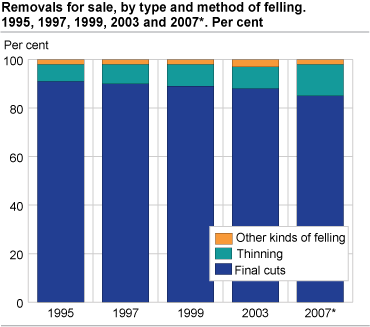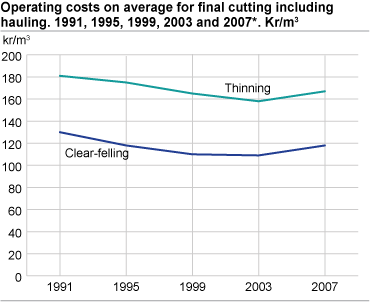Content
Published:
Logging machines take over
About 85 per cent of the roundwood cut for sale in 2007 came from final cutting, and 91 per cent of the total quantity was harvested by logging machines.
Out of the total roundwood cut for sale in 2007, 85 per cent came from final cutting, while 13 per cent came from thinning and 2 per cent from logging of windfall, seed trees and shelter trees. The thinning increased from 9 per cent of the total cut in 2003, while final cutting decreased from 88 per cent. In 2007, 91 per cent of the total quantity for sale was logged by logging machines. In 1999 and 2003, 67 and 85 per cent respectively was harvested by logging machines.
Higher operating costs
In 2007, the contractors were paid an average of NOK 118 per m3 for final cutting including hauling and NOK 167 per m3 for thinning. The operating costs were somewhat lower in 2003, when the corresponding prices were NOK 109 and NOK 158 per m3 respectively.
Operating costs varied considerably among counties. Final cutting included hauling performed by contractors was cheapest in Hedmark, amounting to NOK 101 per m3, while it was most expensive in Hordaland at NOK 166 per m3.
2.300 man-years in forestry
The forest owner carried out 64 per cent of a labour input of 4.2 million man-hours in forestry in 2007. Labour input carried out by contractors and the self-employed is not included in these figures. Labour input of spouses or cohabitants amounted to 8 per cent in 2007, while hired help constituted 28 per cent.
Contractors did more of the planting
Planting and sowing were performed on 8 per cent of the forest properties in 2007, whereas 215 000 decares were planted. Forest owners performed 28 per cent of the planting or sowing, whereas contractors carried out 46 per cent and hired help 26 per cent.
Young forest tending was carried out on 17 per cent of the properties in 2007. The total tended area amounted to 487 000 decares in 2007.
Compared to yearly statistics on silviculture , which are based on transactions in the Forest Trust Fund, the planted area from the Sample Survey of Forestry is larger. The main reason is that not all planting is financed by the Forest Trust Fund.
Profitable forest area
According to the forest owner's estimate, 73 per cent of the forest area was profitable in 2007. Forest owners with small properties estimated that a lesser proportion of the productive forestland was profitable than forest owners with more forestland. Forest owners with at least 5 000 decares of productive forest area estimated that 78 per cent of the productive forest area was profitable. Among forest owners with less than 250 decares of productive forestland, the corresponding percentage was 60.
Forest properties included in the statisticsAs from 2008, the Sample Survey of Forestry 2008 includes properties with at least 100 decares of productive forest area. Until 2004, forest properties with at least 25 decares of productive forest area were included in the statistics. |
Tables:
- Table 1 Removals for sale, by type and method of felling. 2007*. Per cent
- Table 2 Labour input by county and size of productive forest area. 2007*. Man-hours
- Table 3 Forest area planted or seeded by county and productive forest area. 2007*
- Table 4 Forest area with young forest tended, by county and size of productive forest area. 2007*
- Table 5 Profitable area as part of productive forest area, by county and productive forest area. Per cent. 2007*
Contact
-
Statistics Norway's Information Centre
E-mail: informasjon@ssb.no
tel.: (+47) 21 09 46 42


